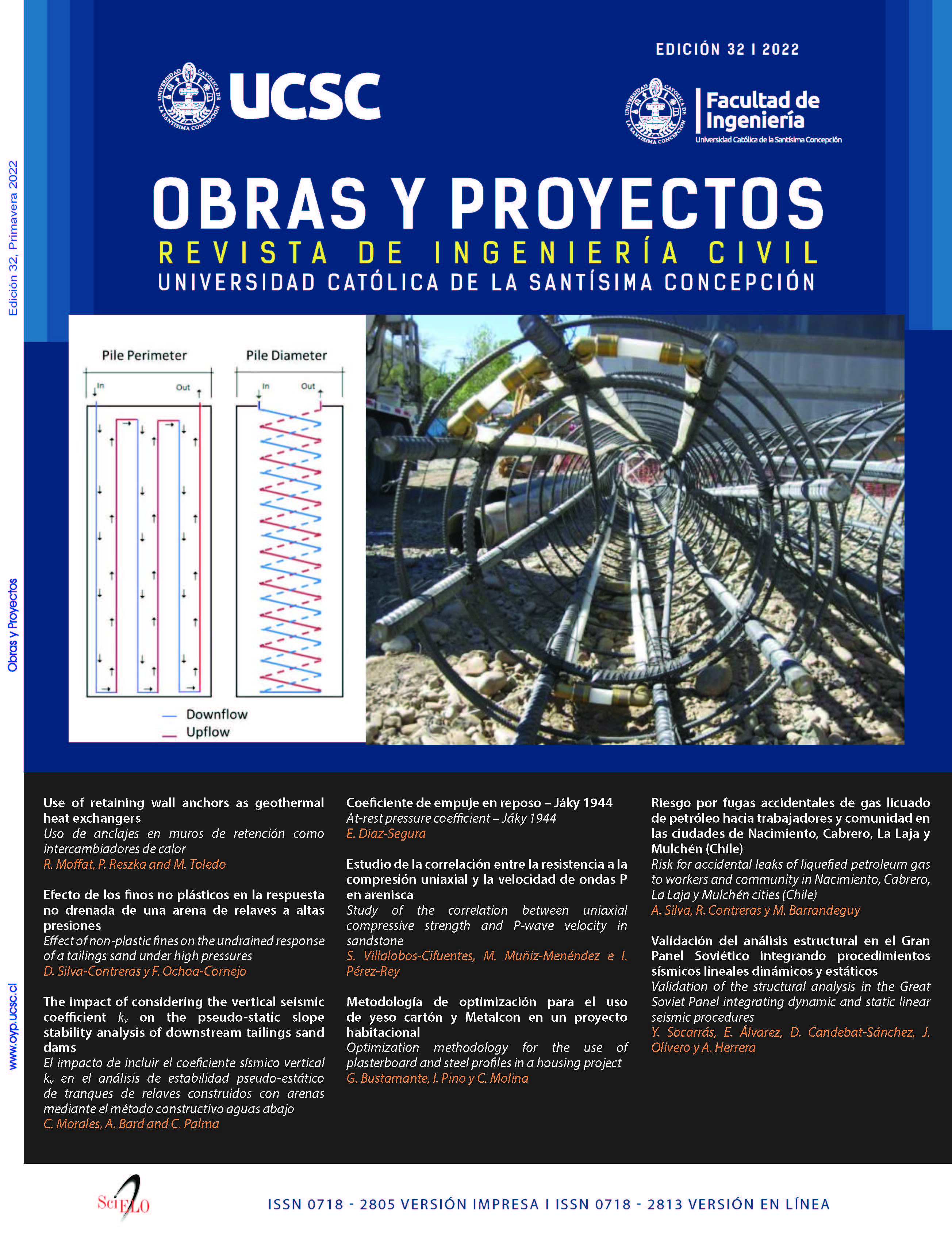El impacto de incluir el coeficiente sísmico vertical kv en el análisis de estabilidad pseudoestático de tranques de relaves construidos con arenas mediante el método constructivo aguas abajo
DOI:
https://doi.org/10.21703/0718-51620202203203Palabras clave:
Análisis pseudo-estático, Tranques de relaves, Coeficiente sísmico verticalResumen
En Chile, de acuerdo con el Decreto Supremo 248 (DS248, 2007), el análisis de equilibrio límite en condiciones pseudoestáticas es obligatorio, debiendo asegurarse un factor de seguridad mínimo (FS) de 1.2. En la práctica geotécnica chilena, generalmente en los análisis se considera solo el coeficiente sísmico horizontal (kh). Sin embargo, existe una constante discusión sobre la necesidad de también aplicar el coeficiente sísmico vertical (kv) en los análisis. Además, existe incertidumbre sobre qué razón de kv/kh se debe considerar para los análisis y el efecto en los factores de seguridad con el sentido de aplicación del coeficiente sísmico vertical (hacia arriba o hacia abajo). Este artículo presenta un análisis del efecto de considerar razones de kv/kh de 0 a 1 en ambas direcciones de análisis para un tranque de relaves genérico con muro de arena, construido mediante el método de aguas abajo para diferentes alturas del muro, longitudes de playa y condiciones de drenaje. Los resultados obtenidos indican que cuando se aplican tanto kh como kv, el FS aumenta si kv actúa hacia abajo y disminuye si actúa hacia arriba. Además, para |kv|/kh ≤ 0.5 el efecto es prácticamente despreciable, especialmente para kh ≤ 0.15. Por último, si bien un largo de playa menor tiene un gran impacto en el FS, la aplicación de kh y de kv parece ser independiente del largo de playa.
Referencias
ANCOLD (2012). Guidelines on tailings dams: planning, design, construction, operation and closure. Australian National Committee on Large Dams ANCOLD, Hobart, Tasmania, Australia.
Barrera, S., Valenzuela, L. and Campaña, J. (2011). Sand tailings dams: design, construction and operation. Tailings and Mine Waste Conference, University of British Columbia, Norman B. Keevil Institute of Mining Engineering, Vancouver BC, Canada.
Blight, G.E. (2010). Geotechnical engineering for mine waste storage facilities. Taylor & Francis, London UK.
Bray, J.D. and Travasarau, T. (2011). Pseudostatic slope stability procedure. 5th International Conference on Earthquake Geotechnical Engineering, SOCHIGE, Santiago, Chile, R. Verdugo (ed.), 255-266.
Bray, J.D., Macedo, J. and Travasarou, T. (2018). Simplified procedure for estimating seismic slope displacements for subduction zone earthquakes. Journal of Geotechnical and Geoenvironmental Engineering 144(3), 04017124.
Campaña, J. (2019). Reflexiones sobre el coeficiente sísmico para análisis seudoestáticos en el diseño de presas. Charla técnica, ICOLD, Santiago, Chile.
DS248 (2007). Reglamento para la aprobación de proyectos de diseño, construcción, operación y cierre de los depósitos de relave. Decreto Supremo, Ministerio de Minería, Servicio Nacional de Geología y Minería SERNAGEOMIN, Santiago, Chile.
DS86 (1970). Reglamento de construcción y operación de tranques de relave. Decreto Supremo, Ministerio de Minería, Santiago, Chile.
ICOLD (2001). Tailings dams - risk of dangerous occurrences, lessons learnt from practical experiences. Bulletin 121. United Nations Environmental Programme UNEP, Division of Technology, Industry and Economics DTIE and International Commission on Large Dams ICOLD, Paris, France.
Kramer, S.L. (1996). Geotechnical earthquake engineering. Prentice-Hall, New Jersey, USA.
Melo, C. and Sharma, S.B. (2004). Seismic coefficients for pseudostatic slope analysis. 13th World Conference on Earthquake Engineering, Vancouver BC, Canada, paper 369.
Morgenstern, N.R. and Price V.E. (1965). The analysis of the stability of general slip surfaces. Géotechnique 15(1), 79-93.
Morgenstern, N.R., Vick, S.G., Viotti, C.B. and Watts, B.D. (2016). Fundão tailings dam review panel: Report on the immediate causes of the failure of the Fundão dam. Cleary Gottlieb Steen & Hamilton, LLP, New York NY, USA.
Morgenstern, N.R., Vick, S.G. and van Zyl, D. (2015). Independent expert engineering investigation and review panel: Report on Mount Polley tailings storage facility breach. Government of the Province of British Columbia, Victoria BC, Canada.
Noda, S. and Uwabe, T. (1976). Relation between seismic coefficient and ground acceleration for gravity quay wall. 6thWorld Conference on Earthquake Engineering, New Delhi, India, vol. 2, 1963-1968.
Ramírez, N. (2010). Effects of the 2010 earthquake on tailings disposals located on the South-Central Chile and its relation with Decreto 248. Seminar: Proposals for the Operation of Tailings Disposals According to Recent Experiences. Santiago, Chile.
Rico, M., Benito, G., Salgueiro, A.R., Díez-Herrero, A. and Pereira, H.G. (2008). Reported tailings dam failures: a review of the European incidents in the worldwide context. Journal of Hazardous Materials 152(2), 846-852.
Robertson, P.K., de Melo, L., Williams, D.J. and Wilson, G.W. (2019). Report of the expert panel on the technical causes of the Failure of Feijão Dam I. Skadden, Arps, Slate, Meagher & Flom LLP, New York NY, USA.
Sahoo, P.P. and Shukla, S.K. (2021). Effect of vertical seismic coefficient on cohesive-frictional soil slope under generalised seismic conditions. International Journal of Geotechnical Engineering 15(1), 107-119.
Sahoo, P.P., Shukla, S.K. and Mohyeddin, A. (2018). Analytical expressions for determining the stability of cohesionless soil slope under generalised seismic conditions. Journal of Mountain Science 15(7), 1559-1571.
Saragoni, R. (1993). Análisis del riesgo sísmico para la reconstrucción del Puerto de Valparaíso. 6tas Jornadas Chilenas de Sismología e Ingeniería Antisísmica, Universidad de Chile y ACHISINA, Santiago, Chile, vol. II, 165-178.
Sarma, S.K. (1975). Seismic stability of earth dams and embankments. Géotechnique 25(4), 743–761.
Sarsby, R.W. (2013). Tailings dams. Chapter 15: Environmental Geotechnics, R.W. Sarsby (ed.), ICE Publishing, London,UK, 2nd edition, 365-391.
Shukha, R. and Baker, R. (2008). Design implications of the vertical pseudo-static coefficient in slope analysis. Computers and Geotechnics 35(1), 86–96.
Slide2 (2018). 2D slope stability analysis program using limit equilibrium method. Version 7.0, Rocscience Inc., Toronto, Canada.
Towhata, I. (2008). Geotechnical earthquake engineering. Springer-Verlag, Berlin, Germany.
Troncoso, J. (2002). Dynamic properties and seismic behavior of thickened tailings deposits. International Symposium on Paste and Thickened Tailings Disposal, Pontificia Universidad Católica de Chile, Santiago, Chile.
Troncoso, J.H. (1996). Geotechnics of tailings dams and sediments. 2nd International Congress on Environmental Geotechnics 2ICEG, Osaka, Japan, M. Kamon (ed.), Balkema, the Netherlands, vol. 3, 1405–1423.
Valenzuela, L. (2016). Design, construction, operation and the effect of fines content and permeability on the seismic performance of tailings sand dams in Chile. Obras y Proyectos 19, 6-22.
Valenzuela, L. (2015). Tailings dams and hydraulic fills. The 2015 Casagrande Lecture. 15th Pan-American Conference on Soil Mechanics and Geotechnical Engineering and 8th South American Congress on Rock Mechanics, Buenos Aires, Argentina, A.O. Sfriso, D. Manzanal and R.J. Rocca (eds.), IOP Press, Amsterdam, the Netherlands, vol. 5, 5-49.
Vick, S.G. (1983). Planning, design and analysis of tailings dams. John Wiley & Sons, New York, USA.
Villavicencio, G., Espinace, R., Palma, J., Fourie, A. and Valenzuela, P. (2014). Failures of sand tailings dams in a highly seismic country. Canadian Geotechnical Journal 51(4), 449-464.
Descargas
Publicado
Número
Sección
Licencia
Derechos de autor 2022 Universidad Católica de la Santísima Concepción

Esta obra está bajo una licencia internacional Creative Commons Atribución-NoComercial 4.0.








